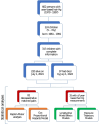Childhood mercury exposure and early death in Grassy Narrows First Nation, Canada: a retrospective study
- PMID: 40545538
- PMCID: PMC12183875
- DOI: 10.1186/s12940-025-01190-7
Childhood mercury exposure and early death in Grassy Narrows First Nation, Canada: a retrospective study
Erratum in
-
Correction: Childhood mercury exposure and early death in Grassy Narrows First Nation, Canada: a retrospective study.Environ Health. 2025 Aug 22;24(1):60. doi: 10.1186/s12940-025-01221-3. Environ Health. 2025. PMID: 40847305 Free PMC article. No abstract available.
Abstract
Background: In 1962, a chloralkali plant began discharging mercury (Hg) into the Wabigoon-English River system, contaminating the territorial waters of Grassy Narrows First Nation, whose traditions, livelihood and diet centered on fish. Data from 1970 to 1997 government Hg biomonitoring programs were repatriated by Grassy Narrows. Our researcher-community partnership carried out secondary analyses to examine the association between childhood Hg exposure (between 5 and 15y) and survival to July 1, 2024.
Methods: Information from the governmental biomonitoring programs and from Grassy Narrows Registry of Band members were used to create a retrospective year-based equivalent hair Hg (HHg) database, with dates of birth, sampling and death (N = 317). Apparent cause of death was reported by community members. Different approaches were used to minimize potential unmeasured confounders in examining the relation between Hg exposure and early death: (i) matched pairs (deceased/alive; same sex, year of birth (± 1) (n = 81) pairs for dissymmetry analysis, Kaplan-Meier survival analysis and Cox proportional hazards regression models (ii) Longitudinal Mixed Effects Models (LMEM) with individuals who had at least 7 year-based HHg measurements (n = 35), and (iii) trajectory techniques modelling exposure.
Results: HHg measurements (n = 1031) were available for 167 boys and 150 girls. Mean age at sampling was 10.5 y (SD: 2.9); 44.2% had HHg ≥ 4 µg/g at least once. By July 1, 2024, 97 individuals (30.6%) had died (median age: 39 years (IQR: 24-49)). The Cox Hazard Ratio for HHg ≥ 4 µg/g at least once was 1.96 [1.18-3.28]. LMEM showed that HHg was 1.46 µg/g higher over the sampling period for the deceased compared to the living. Significant associations (p ≤ 0.001) were also observed for early death with respect to HHg trajectory summary scores (OR: 1.14 to 1.24; SE ≤ 0.78). Reported suicide, liver disease and cardiovascular/metabolic conditions made up 60% of all deaths.
Conclusions: Early mortality in Grassy Narrows First Nation is higher than other First Nations and the non-Indigenous populations in Canada. Convergent findings from different approaches and statistical techniques support an association between childhood Hg exposure and early death. Morbidity and mortality in this community require follow-up.
Keywords: Childhood exposure; Early death; Indigenous health; Mercury; Mortality.
© 2025. The Author(s).
Conflict of interest statement
Declarations. Ethics approval: Ethics approval was obtained from the Institutional Review Board of the Université du Québec à Montréal (Ethics Certificate 2016_e_1350). Consent for publication: Grassy Narrows First Nation Chief and Band Council consented to publication. Competing interests: The authors declare no competing interests.
Figures







References
-
- Youdelis M, Townsend J, Bhattacharyya J, Moola F, Fobister J. Decolonial conservation: Establishing Indigenous protected areas for future generations in the face of extractive capitalism. J Political Ecol. 2021;28(1):990–1022.
-
- Usher PJ, Anderson P, Brody H, Keck J, Torrie J. The social and economic impact of mercury pollution on the whitedog and grassy narrows Indian reserves, Ontario. In. Ottawa, Canada: Usher Consulting Services. 1979.
-
- Vecsey C. Grassy narrows reserve: mercury pollution, social disruption, and natural resources: A question of autonomy. Am Indian Q. 1987;11(4):287–314.
-
- Rudd JWM, Kelly CA, Sellers P, Flett RJ, Townsend BE. Why the English–Wabigoon river system is still polluted by mercury 57 years after its contamination. FACETS. 2021;6:2002–27.
-
- Neff MR, Bhavsar SP, Arhonditsis GB, Fletcher R, Jackson DA. Long-term changes in fish mercury levels in the historically impacted English-Wabigoon river system (Canada). J Environ Monit. 2012;14(9):2327–37. - PubMed
MeSH terms
Substances
Grants and funding
LinkOut - more resources
Full Text Sources
Medical

